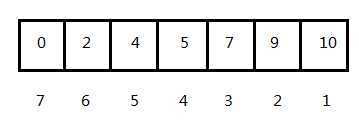Given an array of citations sorted in ascending order (each citation is a non-negative integer) of a researcher, write a function to compute the researcher‘s h-index.
According to the definition of h-index on Wikipedia: "A scientist has index h if h of his/her N papers have at least h citations each, and the other N ? h papers have no more than h citations each."
Example:
Input: citations = [0,1,3,5,6]
Output: 3
Explanation: [0,1,3,5,6] means the researcher has 5 papers in total and each of them had
received 0, 1, 3, 5, 6 citations respectively.
Since the researcher has 3 papers with at least 3 citations each and the remaining
two with no more than 3 citations each, her h-index is 3.
Note:
If there are several possible values for h, the maximum one is taken as the h-index.
Follow up:
想要理解这个算法,必须要弄懂我之前写的 #274 解法二。
看到已排序序列和 O(lgn) 就能联想到这道题的解题方法大概率是二分查找,仔细分析后发现这道题还是二分查找中比较难的那一类,因为要查找的目标值(H-Index)一直在变化。
274题的解法二中我们将数组是从大到小排序,每个位置的 h = 索引值,在这道题里并不适用,所以要重新设计每个位置的 h。
一个比较好的办法是,让每个位置的 h = length - 索引值,这样的话 h 就是一个降序序列,而且很方便获得某个位置的 h,如下图。原理很简单:如果一个位置上的 h 是题目想要的 H-Index,那么就有 citations[0..h-1] ≤ h 且 citations[h..n] ≥ h。

然后,在二分查找的过程中,如果某个 h 值满足条件(即 h 值 ≤ 它对应的值,比如元素 5 在的位置 h = 4,此时有 4 篇论文的引用 ≥ 4,其余 len - h = 3 篇论文的引用 ≤ 4),我们就可以直接到前半部分继续查找满足条件且更大的 h 值;同理,如果 h 值不满足条件(即 h 值 > 它对应的值),我们就到后半部分继续查找。
对于 corner case,比如 [], [0], [1, 2] 这样的数据,我们需要重新设计二分查找中的判断条件,比如将 while 的条件改成 left ≤ right,每次右移时将 right 赋值为 mid - 1 而不是 mid 以避免死循环。
时间复杂度:O(lgn)
空间复杂度:O(1)
耗时 20 ms, Memory 10.2 MB, ranking 86.57%
class Solution {
public:
int hIndex(vector<int> &citations) {
int len = citations.size();
int left = 0;
int right = len - 1; // set right as len-1 so as to pass [], [0]
while (left <= right) {
int mid = left + (right - left)/2;
int h = len - mid;
if (h <= citations[mid]) {
right = mid - 1; // there is forever loop if right = mid
} else {
left = mid + 1;
}
}
// after while, left = mid. if there is a solution,
// then len - left = correct h, and left = right + 1
return len - left;
}
};
利用左闭右开思想,我们可以把 left 和 right 分别设为 0 和 n。当每次扫描完一个元素时,如果符合要求,则将 right 移动到该元素的位置上,表示该搜索区间已去除该元素,此后不再扫描它;否则将 left 移动到 mid + 1 的位置,搜索区间缩小至 [mid + 1, right),同样将该元素踢出搜索区间。当 left = right 时,说明搜索区间为空,可以终止搜索了。
这么做的好处是,不必再为代码哪里冒出来的 +1 -1 < ≤ return 所烦恼,同时也不必烦恼 left 和 right 哪一个才是最后的正确结果,大大降低代码出错率。
算法的通用步骤如下(相当于 c++ STL中的 std::lower_bound),应该可以处理任何二分查找的问题,也可以处理特殊的 corner case,比如本题的 [0, 0, 0] 和 [1, 2]:
最后 jump 出去后,left 和 right 必相等,任选其中一个就是我们想要的答案。
根据这个思路,我们重写本题的二分查找算法
class Solution {
public:
int hIndex(const vector<int> &citations) {
int len = citations.size();
int left = 0;
int right = len; // set right as len-1 so as to pass [], [0]
while (left < right) {
int mid = left + (right - left)/2;
int h = len - mid;
if (h <= citations[mid]) {
right = mid; // there is forever loop if right = mid
} else {
left = mid + 1;
}
}
return len - left;
}
};
LeetCode #275. H-Index II 数组 二分查找
原文:https://www.cnblogs.com/Bw98blogs/p/12727674.html